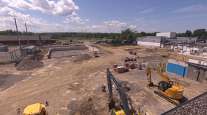Staff Reporter
TRIP Report Finds 10% of New York’s Bridges Are Structurally Deficient

[Stay on top of transportation news: Get TTNews in your inbox.]
Ten percent of New York state’s bridges are structurally deficient and continue to bear millions of vehicles per day, according to a recent report from The Road Information Program.
Known as TRIP, the nonprofit group researches surface transportation issues and promotes policies relating to traffic relief and travel safety. A bridge earns a poor/structurally deficient rating if there is significant deterioration of the deck, supports or other major components.
TRIP’s report, titled “Preserving New York’s Bridges,” was released Sept. 18. According to the report, New York’s structurally deficient bridges carry more than 11.5 million vehicles per day. Over 4.3 million vehicles travel over poor bridges every day in New York City. In the Hudson Valley, about 2.5 million vehicles cross poor bridges daily.
NY Statewide Preserving New... by Transport Topics on Scribd
Sometimes deficient bridges will be closed or posted for weight restrictions, forcing heavier vehicles such as trucks, buses and farm equipment to find alternate routes that result in lost time and money.
“Poor bridge condition ratings negatively impact functionality, time of travel, safety, the local economy and the overall experience of the traveling public,” said Dennis Davis, president of the New York State County Highway Superintendents Association. “With many aging bridges more than 70 years old, not to mention tens of thousands of culverts also requiring immediate reconstruction or replacement, we face a situation in desperate need of increased public investment and a concerted effort on the part of all levels of government to address the funding demands of our aging and ailing transportation systems.”
The report indicates that 53% of New York’s bridges are in fair condition, meaning their structural elements are sound but have experienced minor deterioration. The remaining 37% of the state’s bridges are in good condition.
TRIP’s report notes that New York’s bridge system is vital to supporting its economy, particularly the agriculture, manufacturing and tourism industries. Some $1.3 trillion in goods is moved to and from sites in New York every year, mostly by truck. The value of freight shipped to and from sites in New York is expected to increase by 154% from 2016 to 2045.
On average, the state’s poor/structurally deficient bridges are 70 years old. The average age of all of the state’s bridges is 50 years, which generally is the intended design life for a bridge built during that era.
Maintaining bridges becomes more expensive as the structures get older. According to the report, the Federal Highway Administration estimates it would cost $3.6 billion to replace or rehabilitate all of New York’s structurally deficient bridges.
A Government Accountability Office report from 2016 reflected that officials from 14 out of 24 states identified inadequate funding as a challenge to their ability to maintain bridges.
Increased funding from local, state and federal government agencies is required to make needed bridge improvements, the report states. Funding is essential to sustain bridge preservation efforts, which can include washing, sealing deck joints and concrete, removing debris and facilitating drainage.
WANT MORE NEWS? Listen to today's Daily Briefing
“Every day, millions of people travel through our state on what are often poor and structurally deficient roads and bridges,” said state Sen. Timothy Kennedy, chairman of the Committee on Transportation. “Now more than ever, we need to ensure that we’re dedicating resources to local infrastructure that is desperately in need of repair and maintenance. Taxpayer dollars must be put to work to improve our local community.”




